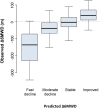Individualized Prediction of Changes in 6-Minute Walk Distance for Patients with Duchenne Muscular Dystrophy
- PMID: 27737016
- PMCID: PMC5063281
- DOI: 10.1371/journal.pone.0164684
Individualized Prediction of Changes in 6-Minute Walk Distance for Patients with Duchenne Muscular Dystrophy
Abstract
Background: Deficits in ambulatory function progress at heterogeneous rates among individuals with Duchenne muscular dystrophy (DMD). The resulting inherent variability in ambulatory outcomes has complicated the design of drug efficacy trials and clouded the interpretation of trial results. We developed a prediction model for 1-year change in the six minute walk distance (6MWD) among DMD patients, and compared its predictive value to that of commonly used prognostic factors (age, baseline 6MWD, and steroid use).
Methods: Natural history data were collected from DMD patients at routine follow up visits approximately every 6 months over the course of 2-5 years. Assessments included ambulatory function and steroid use. The annualized change in 6MWD (Δ6MWD) was studied between all pairs of visits separated by 8-16 months. Prediction models were developed using multivariable regression for repeated measures, and evaluated using cross-validation.
Results: Among n = 191 follow-up intervals (n = 39 boys), mean starting age was 9.4 years, mean starting 6MWD was 351.8 meters, and 75% had received steroids for at least one year. Over the subsequent 8-16 months, mean Δ6MWD was -37.0 meters with a standard deviation (SD) of 93.7 meters. Predictions based on a composite of age, baseline 6MWD, and steroid use explained 28% of variation in Δ6MWD (R2 = 0.28, residual SD = 79.4 meters). A broadened prognostic model, adding timed 10-meter walk/run, 4-stair climb, and rise from supine, as well as height and weight, significantly improved prediction, explaining 59% of variation in Δ6MWD after cross-validation (R2 = 0.59, residual SD = 59.7 meters).
Conclusions: A prognostic model incorporating timed function tests significantly improved prediction of 1-year changes in 6MWD. Explained variation was more than doubled compared to predictions based only on age, baseline 6MWD, and steroid use. There is significant potential for composite prognostic models to inform DMD clinical trials and clinical practice.
Conflict of interest statement
JES, ES and JS are employees of Analysis Group, Inc., which received funding via the Collaborative Trajectory Anlaysis Project (cTAP) for this research. This does not alter our adherence to PLOS ONE policies on sharing data and materials.
Figures



References
-
- Chung J, Smith AL, Hughes SC, Niizawa G, Abdel-Hamid HZ, Naylor EW, et al. Twenty-year follow-up of newborn screening for patients with muscular dystrophy. Muscle Nerve. 2015. - PubMed
-
- Emery AEH, Muntoni F, Quinlivan R. Duchenne muscular dystrophy. 4th ed Oxford: Oxford University Press; 2015.
MeSH terms
Substances
LinkOut - more resources
Full Text Sources
Other Literature Sources
Medical

